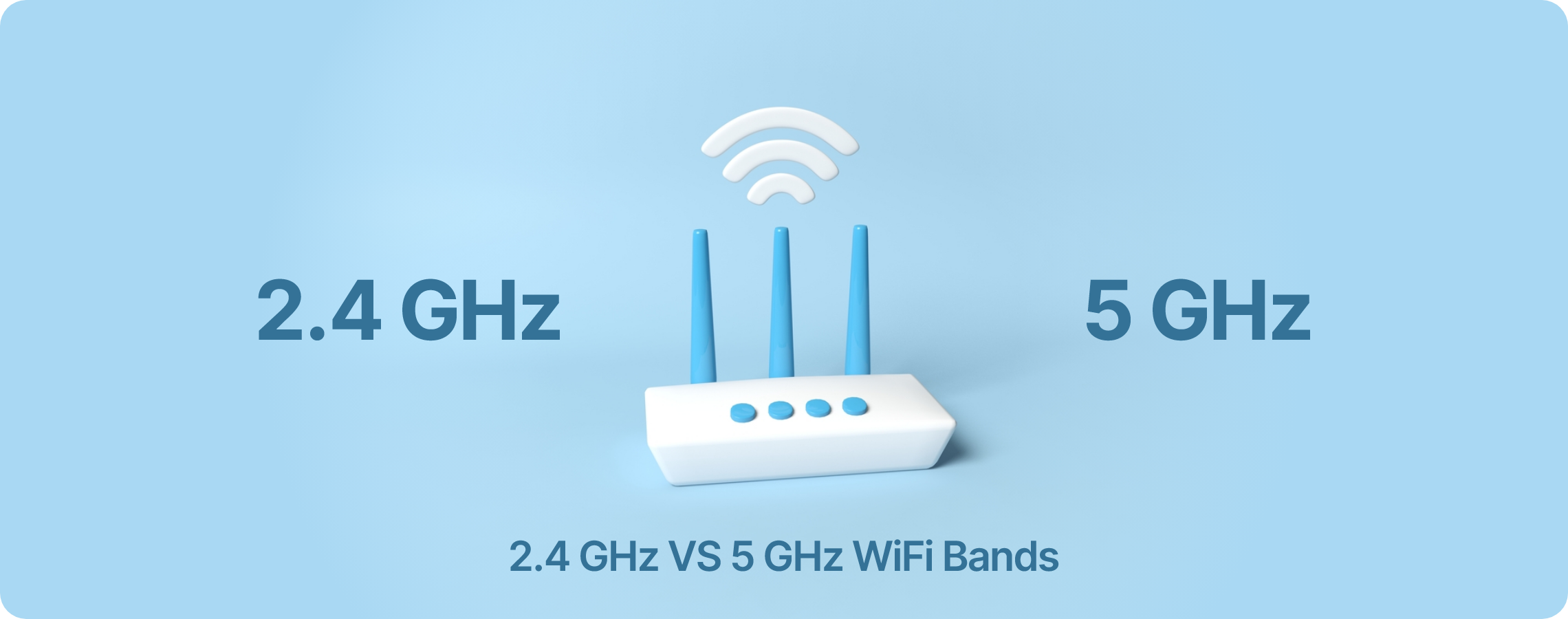 Feb 12, 2024
Feb 12, 2024

WiFi has become a need in our day-to-day existence. Our online experiences are greatly impacted by the quality of our WiFi connection, whether we are working remotely, streaming films, or simply keeping in touch with friends and family.
It's critical to comprehend the distinctions between the two most widely used WiFi bands, 2.4 GHz and 5 GHz, to guarantee flawless communication.

2.4 GHz WiFi a popular frequency for wireless communication, renowned for its wide coverage and interoperability with a range of devices, including older ones.
Larger rooms benefit greatly from it, although its performance may be impacted by interference from other household devices that share the same frequency.
Wider Range: The wider range coverage of 2.4 GHz WiFi is one of its main benefits. Because 2.4 GHz is a lower frequency, its signals can travel farther and more efficiently pass through walls and other obstructions.
Because of this, it's a great option for larger houses or places where keeping connectivity across rooms is crucial.
Better Wall Penetration: One notable advantage of 2.4 GHz signals is their capacity to pass through walls and other obstructions.
When your router is situated in a single room, 2.4 GHz WiFi can frequently connect to devices in nearby rooms with little to no signal loss. This is especially helpful in houses with several storeys or thick walls.
Interference: Although 2.4 GHz WiFi has a greater coverage area, interference is a greater risk with it.
In addition to being widely utilized for WiFi, this frequency band is also used by a number of other home appliances, including microwaves, baby monitors, and cordless phones, all of which can interfere.
Slower network speeds and signal congestion may result from this interference.
Slower Speed: Compared to the 5 GHz band, the maximum speed of 2.4 GHz WiFi is slower, which is another disadvantage.
Because the 2.4 GHz band sometimes has slower data transmission speeds, it is not as good for high-bandwidth tasks like online gaming or HD streaming.
This restriction might be quite detrimental if you need quicker internet speeds or if you have multiple devices connected at once.

5 GHz WiFi is a well-known frequency range for wireless communication that is distinguished from 2.4 GHz by its higher speeds and lower interference.
Higher Speed: The considerably higher maximum speed of 5 GHz WiFi is possibly its most notable advantage.
Faster data transfer rates are offered by this frequency range, which makes it perfect for bandwidth-intensive applications like online gaming, high-definition streaming, and big file downloads. The 5 GHz band is the best option if speed and minimal latency are your top priorities.
Reduced Interference: The 5 GHz band has a wider variety of non-overlapping channels than the congested 2.4 GHz frequency. This implies that the likelihood of interference from nearby networks or other electrical equipment is reduced.
More steady and dependable connections result from less interference, especially in places with many WiFi networks or dense populations.
Limited Range: 5 GHz WiFi's higher frequency has a trade-off in that it has a smaller coverage area. Compared to the 2.4 GHz range, the 5 GHz band does not carry signals as far.
If your network is too far away from your devices, you may suffer dead zones or signal drop-off, which can be troublesome in bigger homes or locations.
Weaker Wall Penetration: The 5 GHz band's less ability to pass through obstructions like walls is another disadvantage.
Higher frequency signals are less successful at reaching devices in separate rooms because they are more easily absorbed or reflected by walls, especially when there are many floors or walls present.

Use Case: Your intended use case is the main consideration when deciding between 2.4 GHz and 5 GHz WiFi.
2.4 GHz: Use 2.4 GHz if you use it for email, web browsing, or connecting older devices that might not be able to support 5 GHz. Additionally, it works well in bigger spaces with several rooms where signal reach is important.
5 GHz: For applications that require quick data transfer, including online gaming, high-definition streaming, or other jobs, pick 5 GHz when speed and low latency are critical. It is excellent at providing a smooth experience for these kinds of activities.
Location: WiFi performance is heavily influenced by your physical surroundings.
2.4 GHz: This frequency may be more appropriate if your router is positioned in the centre and you require coverage through walls or over a greater region. It can more easily go around barriers and maintain connectivity in difficult-to-reach areas.
5 GHz: This frequency is a great option for settings with little physical barriers and close proximity between the router and devices. It works best in areas with less walls to contend with, such as open spaces or smaller flats.
Devices: Your choice should also be influenced by the devices you intend to connect:
2.4 GHz: Use the 2.4 GHz frequency to connect devices that are outdated or have less powerful WiFi. This guarantees stability and compatibility for gadgets that might not be able to support 5 GHz.
5 GHz: For contemporary smartphones, laptops, tablets, and other gadgets that can benefit from its faster speeds, use 5 GHz. This guarantees a more responsive and quick experience.
In the end, both 2.4 GHz and 5 GHz WiFi bands have their strengths and weaknesses, and understanding how they align with your requirements will ensure you have a wireless network that serves your needs effectively.
So, make your decision wisely and enjoy a seamless online experience tailored to your preferences.
If you're looking for a reliable and high-speed broadband connection, Mach1 Broadband is here to serve you. Visit Mach1 Broadband today.
To further enhance your WiFi experience and assist you in making an informed decision, here are some additional tips and resources:
Router Placement: Position your router centrally for optimal coverage. Elevate it if possible, and keep it away from thick walls, metal objects, and electronic appliances that may cause interference.
Firmware Updates: Regularly update your router's firmware to ensure it has the latest security patches and performance improvements.
Network Security: Secure your WiFi network with a strong password and encryption method to prevent unauthorized access.
Channel Selection: In congested areas, consider changing your router's channel to reduce interference from neighboring networks.
Quality of Service (QoS): Utilize QoS settings on your router to prioritize specific devices or applications for a smoother experience.
WiFi Range Extenders: If you have dead zones, consider adding WiFi range extenders or a mesh system to expand coverage.
Federal Communications Commission (FCC) WiFi Tips - Helpful information on optimizing your home WiFi network.
SpeedTest - Test your internet speed to assess the performance of your WiFi connection.
Also read our blog on “9 tips to How to boost internet speed”.